Revista Electrónica de Investigación Educativa
Vol. 11, Num. 1, 2009
Gender and Degree Programs: The Interest for an
Academic Field, a Factor that Influences
the Choice of a Bachelors Degree
José Gamboa García
jgamboa@uach.mx
Departamento de Educación Continua, Abierta y a Distancia
Universidad Autónoma de Chihuahua
Campus I s/n, C.P. 31110
Chihuahua, Chihuahua, México
Rigoberto Marín Uribe
rmarin@uach.mx
Universidad Autónoma de Chihuahua
Filomeno Mata 2322, Fracc. Francisco I. Madero
Chihuahua, Chihuahua, México
(Received: September 4, 2007;
accepted for publishing: July 17, 2008)
Abstract
As part of a study on the expectations of benefit of higher education applicants, this article approaches the choice of a degree program according to the academic interest from the perspective of the rational analysis. Applicants who took the admissions test in two institutions were surveyed in order to carry out later statistical analysis with the purpose of finding a multivariate model. The obtained results showed that gender, work, and age were related to the applicants’ interest on certain academic degree program. The interest for a degree program tends to be unimportant in employed women’s choices, aged 20 years or older. Among applicants whose father considered higher education very important, the probability to consider one’s interest on the choice of a bachelor’s degree was higher for male applicants. The above information confirms the variation in rational calculations regarding social characteristics.
Key words: Career choice, gender differences, decision making.
Introduction
Studies on educational expectations and decisions have not become the main focus in Latin America’s social research. However, different proposals have been developed to explain the decision -making process and the role that expectations play within it. Wright (2005) classifies the decision- making process into three models. The first one called Models of economic/instrumental rationality; they see decision making as a rational process of gathering evidence and weighing up the costs and benefits of alternative courses of action, as expressed by human capital theorists. The second called Structuralist models consider that decisions are a result of external forces (such as gender, class, and ethnicity), the influence of other individuals (such as family and teachers), the nature of education and economic conditions (such labor market opportunities). These models emphasize emotional factors, preconceptions, and assumptions in decision-making, and which derived from the external forces previously mentioned. The third are Hybrid models, which are the most common ones in recent research. Hybrid models aim to accommodate both the role of external structures and individual agency and identity.
This research was carried out according to the last model mentioned; people characteristics, because of their social class, are assumed to be related to peculiarities of their rational analysis. People have expectations when they decide on their academic life; however, different factors are considered when making a decision within the different social classes, so expectations have a different degree of rationality. The position of an individual in a given society allows him/ her to have different perspectives, values, social skills and data access, as well as different capabilities to interpret it.
From the mentioned above, one can deduce that rationality of decisions is necessarily defined by non-rational facts, moreover, what is convenient and rational for someone may not be convenient for another one from a different social class. Many research studies have focused on economic and cost-benefit relationships analysis; however, other facts must be considered in the rational search of goals as far as educational expectations are concerned (Sallop and Kirby, 2007).
Malgwi, Howe and Burnaby (2005), in their research on business students, found that gender was an important factor that influenced the choice of a Major. The results of that study showed that the most important factor of influence for female and male students was interest for the field of study; however, female students, considered their skills were important too; while, male students considered the income potential of the major of their choice was important also. First grade students did not seem influenced by previous studies nor the counselors; not even by their own parents.
Song and Glick (2004) found differences related to gender and ethnicity. Chinese, Philippine, and Southeast Asian female students chose majors with greater income potential than Caucasian students did. They did not find important differences between white students and Korean students. However, they found that male students living with families speaking a foreign language chose more lucrative majors. The level of education of the mother, the family structure, and the parents’ involvement in their children education had the greatest influence on their adult children when they applied for higher education.
Lackland and De Lisi (2001) suggested that the students’ value system worked better as an indicator on the choice of a major than success expectations did. They also found that students who emphasized the income potential of a bachelor’s degree were more likely to choose a degree in science.
Turner and Bowen (1999) mentioned that male and female students chose different majors. They found that one’s different academic interests, labor market expectations, previous studies and educational factors, which are not detected by tests, influenced on students.
On the other hand, Leppel, Williams, and Waldauer (2001) found differences related to the influence of socioeconomic factors on the choice of a major. Regardless of the gender, students from wealthy families were more likely to choose business degree programs, and students whose father was a professional or an executive chose degrees in engineering or sciences, although some gender differences were found. Daughters of professional or executive mothers were less likely to choose the academic field than the others, while the opposite happened to male students. In general, the father’s job influenced on female students and the mothers’ on men. Moreover, the socioeconomic factor had a greater influence on male students than on female students.
In a research on students of high academic achievement and about to graduate from high school, Marks and Houston (2002) found that female students considered maternity in their long-term plans, so they sought bachelor’s degrees that would allow them to combine work with family duties.
Having in mind the idea of the professor as role model, Canes and Rosen (1995) found that the professors’ gender does not influence on the choice of a degree program. In Mexico, Bartolucci (1994) found that the choice of a degree program is derived from the balance of the student’s gender, age, social background and academic achievement, among other variables, none of them being more predominant than the others.
Although gender as an influence factor on the choice of a degree program has drawn the attention, it is clear that there is a lack of research studies that link interests for an academic field to decisions (Wright, 2005). It is precisely in these terms of the interest for an academic field as a factor that influences on the choice of a Bachelors Degree, and its relationship with gender, that this research will try to contribute.
I. Method
1.1 Research Design
According to Johnson and Christensen (2004), this is retrospective, cross- sectional, explanatory non-experimental research. The method is mixed, sequential, and quantitative-qualitative, with the purpose of a complementary use.
The results of the quantitative analysis are presented here. Socio-cultural and academic characteristics are approached only when they are related to the interest for an academic field as a factor that influences on the choice of a Bachelors Degree.
1.2 Population
A survey was administered to those students who applied for the Instituto Tecnológico de Chihuahua (Technological Institute of Chihuahua) and the Schools of Philosophy and Chemistry of the Autonomous University of Chihuahua. The survey was applied to 1,386 applicants.
1.3 Instruments
A questionnaire of 65 questions was designed; it included socio-cultural variables of the applicants and their parents, as well as the applicants’ knowledge on the labor market and their academic and economic expectations.
1.4 Procedure
The instrument was delivered and collected together with the admissions test. Socio-cultural questions were classified into three groups: the first one related to the applicant, the second to the father, and the third to the mother.
Statistical relations were sought among the items in the same group, and the dependent variable, which in this case was the interest for the bachelors degree program that the student applied for (“Degree program of his/her choice”). This variable was created from the item question “What was your favorite subject in high school?” If the subject given by the student was related to the degree program he/ she applied for, the interest for the academic field was considered in the decision-making process.
When the opposite occurred, the interest was an indicator of the fact that the interest for the academic field was not part of the decision-making process. For example, if someone mentioned that his/her favorite subject was mathematics, but applied for Spanish Literature, it was interpreted that this applicant did not take into consideration his/her interests to make a decision on his/her academic future. Since most variables were categorical, the log-linear1 method was used for statistical analysis. SPPS 14 for Windows was used.
II. Results
2.1 Descriptive results
Gender distribution was almost equal: 50.2% were female applicants and 49.5% were male applicants. Four-fifths of the applicants were under 20 years old when they presented their admissions test and just over a quarter of the applicants were working at the time of their admissions test.
Most of the applicants (82.8%) confirmed that his/her father considered highly important to study a degree program. 61.1% of applicants applied for a degree program of their choice.
2.2 Statistical Analysis
To avoid empty cells, values of variables were grouped, so most of them were binary. Both independent and dependent variables were categorical.
Multivariate relationships were aimed, since through a simple inspection it was extremely hard to find possible interactive relationships among variables based on the four settled. Multivariate analysis such as the log-linear model was used for this purpose (Losh, 2006). This allowed finding statistical relationships in tables which included more than two variables, with the only limitation of the number of empty cells.
This type of statistical analysis allowed to find indirect or interactive effects that otherwise would be overlooked, especially when the main or direct effects were not easily observed. Through the log-linear analysis, a significant multivariate model was found according to the parameters given by Losh (2006). Table I shows the model and its statistics.
Table I. Goodness-of-fit

The found model included three associations among variables:
1) DSEXO * DEDAD * DIMPCARPAD
2) DSEXO * DEDAD * DTRABSUJ * DMATFAV
3) DSEXO * DIMPCARPAD * DMATFAV
The log-linear analysis does not distinguish between dependent and independent variables: the order in which they are presented is irrelevant. DSEXO corresponds to the “applicants’ gender”, DEDAD corresponds to the “applicant’s age”, DTRABSUJ corresponds to the question “does the applicant work?” DIMPCARPAD corresponds to the “importance the applicant’s father gave to study a degree program”, and the dependent question DMATFAV corresponds to “degree program of his/her choice”.
In this case, the first association (DSEXO * DEDAD * DIMPCARPAD) was not of the interest for this research, since it does not include the dependent variable (MATFAV). No relationship was found to the applicant’s marital status, the mother characteristics, the socioeconomic status, or the high school GPA (grade point average).
The adjusted model showed a likelihood ratio with significance less than 0.80 and greater than 0.20, consequently it was acceptable (Losh, 2006). According to other parameters, the model is statistically adequate. Figure 1 shows that both observed and expected frequencies are very similar, according to the adjusted model (Garson, 2006).
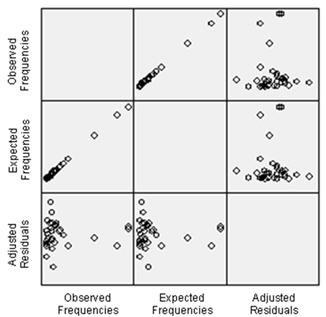
Figure 1. Observed and expected frequencies
On the other hand, the closeness of data to a 45° angle line, as shown in Figure 2, suggests that residuals had a normal distribution, which can be interpreted as another indicator of the fact that the model presents a proper adjustment (Garson, 2006).
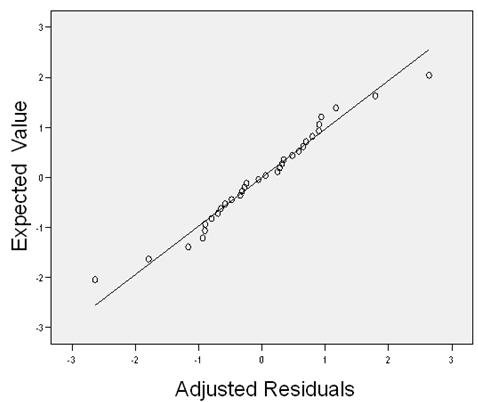
Figure 2. Normal Q-Q graph of adjusted residuals
Log-linear analysis does not specify if effects are main or indirect, it just shows the relationship among variables. According to Losh (2006) correlations were used for both knowing the main and direct effects of each independent variable and knowing the indirect or interactive effects. Table II shows Spearman’s correlations for main effects:
Table II. Spearman Rho correlations for direct and main effects
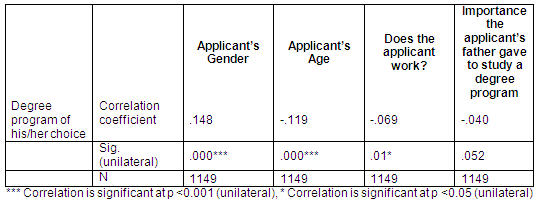
*** Correlation is significant at p <0.001 (unilateral), * Correlation is significant at p <0.05 (unilateral)
For the correct interpretation of Table II, it is necessary to know the variable values shown in Table III.
Table III. Variable Values of the Model

From Table II it is deduced that male applicants were more likely to apply for a degree program of their choice than female applicants, since including gender also increased the “Degree program of his/her Choice” value.
On the other hand, 20-year applicants or older were less likely to study a bachelor’s degree of their choice, since as age increased (from 19 years or under to 20 years or more) the “Degree program of his/her Choice” value decreased. Applicants who had worked were also less likely to apply for a degree program of their choice, although the correlation was smaller. The correlation between the variable “importance the applicant’s father gave to study a degree program” and the dependent variable did not result significant. It did not have a direct influence effect.
Regarding the first relationship of interest (DSEXO * DEDAD * DTRABSUJ * DMATFAV), interactive effects were presented, which are detailed in Table IV.
Table IV. Spearman Rho correlations of “Does the applicant work?” by “Degree program of his/her Choice” in multivariate groups.
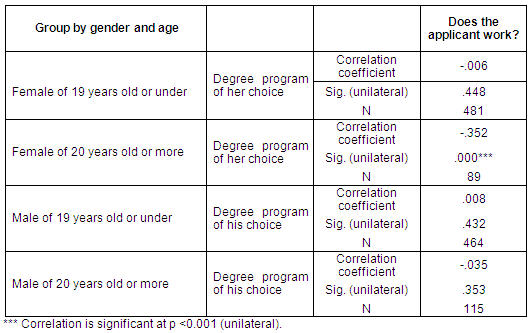
*** Correlation is significant at p <0.001 (unilateral).
In Table IV, it can be observed that for both male applicants of any age and female applicants of 19 or under , no relationship was found between work and the degree program of his/her choice: correlation was not significant. However, for women of 20 years or more a negative correlation was found between work and the degree program of their choice. This means that when the value for the variable “Does the applicant work?” increased, the interest for the degree program decreased for female applicants of 19 or older. The probability for an employed female student of 20 or more to apply for a degree program of her choice was lower than that of any other group of applicants, whatever the combination of variable values were.
Table V shows the interactive effects of the second relationship of interest (DSEXO * DIMPCARPAD * DMATFAV).
Table V. Spearman Rho correlations between “Gender” and “Degree program of his/her choice”, according to “importance the applicant’s father gave to study a degree program”
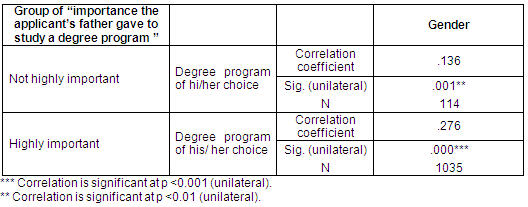
Both correlation coefficients were positive, in other words, when the value of the variable “gender” increased, also the variable “degree program of his/her choice” did. As for those applicants whose parents considered important or not the study of a degree program, male students were more likely to apply for a degree program of their choice, than female students. However, among applicants whose parents considered highly important for their daughters or sons to apply for a bachelor’s degree, male students had the greatest probability to apply for a degree program of their choice.
III. Discussion
In this research, it was found that the interest for an academic field as a factor that influences one’s choice of a degree program was related to gender; though it did not have a great main effect and it was not that important as it was when it interacted with the variables age, work, and the importance given to a bachelor’s degree by parents.
In contrast to Malgwi et al. (2005) as well as Turner and Bowen (1999), the interest for the academic field was not an important factor for any gender; though, it was more important for male applicants, but they did not show great concern. Also, opposite to Malgwi et al. (2005), parents influence on the choice of a degree program was found, although only through gender. The fact that parents had a bachelor’s degree increased the probability for male students to choose a degree program of their interest.
Socioeconomic characteristics seemed not to be related to the interest for the degree program as a factor in the decision-making process for both genders; in contrast to what was suggested by Leppel, Williams and Waldauer (2001). Based on the elements that applicants considered for the choice of a degree program, according to Bartolucci (1994), only gender and age were found. Neither applicants’ academic achievement nor social background seemed to be factors of influence when choosing a degree program.
Generally, female applicants had a lower probability than men did of choosing a degree program of their interest, and when they were older than 19 and worked the probability to study a degree program of their choice decreased considerably. This suggests that these factors may take women to consider other priorities when deciding on the best degree program choice. Perhaps, along with the findings made by Marks and Houston (2002), women may seek a degree program that gives them time for their family duties.
IV. Conclusions
In this study, differences were found on the choice of a degree program related to gender. This influenced directly and interacted with the variables of age, work, and the importance the applicant’s father gave to study a degree program. According to the combination of the variable values mentioned, the interest for a degree program may be or not an important factor to choose it.
Male applicants, applicants under 20 and those who worked had a slightly higher probability of choosing a degree program of their interest. However, employed female applicants who were older than 19 years had very low probabilities of choosing a degree program of their interest. Different factors apart from the interest for a degree program made them choose a degree program: their priorities were others.
Finally, it is concluded that there is a need for more research studies on educational decision-making. Likewise, other approaches based on qualitative methodology can surely provide valuable data.
References
Bartolucci, J. (1994). Desigualdad social, educación superior y sociología en México. Mexico: Porrúa.
Canes, B. J. & Rosen, H. S. (1995). Following in her footsteps? Faculty gender composition and women’s choices of college majors. Industrial & Labor Relations Review, 48, 486-504
Garson, G. D. (2006). Log-linear, logit, and probit models. Retrieved March 1, 2006, from North Carolina State University Web site: http://www2.chass.ncsu.edu/garson/pa765/logit.htm
Johnson, B. & Christensen L. (2004). Educational research: Quantitative, qualitative, and mixed approaches. Retrieved June 20, 2004, from University of South Alabama Web site: http://www.southalabama.edu/coe/bset/johnson/2lectures.htm
Lackland, A. C. & De Lisi, R . (2001). Students’ choices of college majors that are gender traditional and nontraditional. Journal of College Student Development, 42, 39-48.
Leppel, K, Williams, M. L., & Waldauer, C. (2001).The impact of parental occupation and socioeconomic status on choice of college major. Journal of Family and Economic Issues, 22, 373-394.
Losh, S. C. (2006). The multivariate analysis of categorical data. Retrieved May 1, 2006, from: http://mailer.fsu.edu/~slosh/CatDataGuide4.html
Malgwi, C. A., Howe, M. A., & Burnaby, P. A. (2005). Influences on students’ choice of college major. Journal of Education for Business, 80, 275-282.
Marks, G. & Houston, D. M. (2002).The determinants of young women’s Intentions about education, career development and family life. Journal of Education & Work, 15 (3), 321-336.
Sallop, L. J. & Kirby, S. L. (2007). The role of gender and work experience on career and work force diversity expectations. Journal of Behavioral and Applied Management, 8, 122-130.
Song, C. & Glick, J. E. (2004). College attendance and choice of college majors among Asian-American students. Social Science Quarterly, 85, 1401-1421.
Turner, S. E. & Bowen, W. G. (1999). Choice of major: The changing (unchanging) gender gap. Industrial & Labor Relations Review, 52, 289-313.
Wright, S. (2005). Young people’s decision-making in 14-19 education and training: a review of the literature. The Nuffield Review of 14-19 education & Training (Briefing paper 4) Retrieved December 2, 2005, from: http://www.nuffield14-19review.org.uk/files/documents91-1.pdf
Translator: Eleonora Lozano and Ana Carolina Vizcarra
1The log-linear method allows the analysis of multivariate contingency tables using the natural logarithm of the frequencies of the cells. Log-linear seeks for relationships among variables by eliminating non-significant interactions until reaching a model that includes the lowest number of interactions, but that can be fitted to the table of observed data. It is similar to the analysis of variance, but for categorical data. For further detailed information please see Losh (2006).
Please cite the source as:
Gamboa, J. & Marín, R. (2009). Gender and degree programs: The interest for an academic field, a factor that influencies the choice of a bachelors degree. Revista Electrónica de Investigación Educativa, 11 (1). Retrieved month day, year, from: http://redie.ens.uabc.mx/vol11no1/contents-gamboa.html






